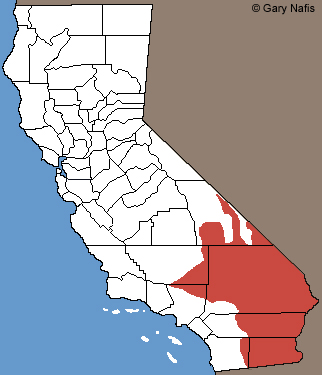|
 |
| Juvenile, Imperial County |
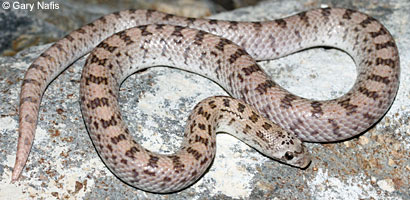 |
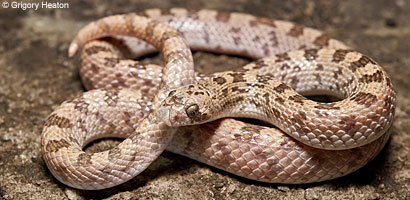 |
| Adult, Inyo County |
Adult, Inyo County © Grigory Heaton |
 |
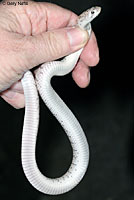 |
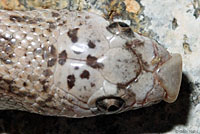 |
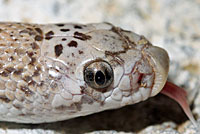 |
| Adult, Inyo County |
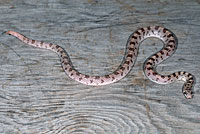 |
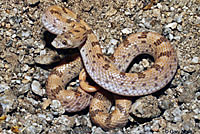 |
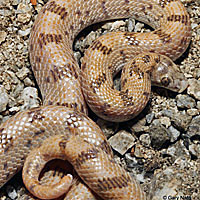 |
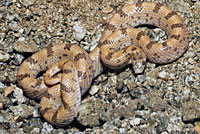 |
| Adult, San Bernardino County |
Adult with peach coloring, San Diego County |
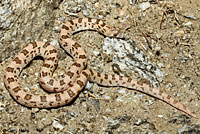 |
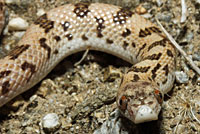 |
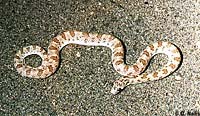 |
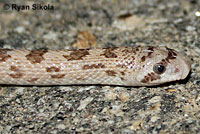 |
| Adult, San Diego County |
Adult, Imperial County |
Adult, Kern County © Ryan Sikola |
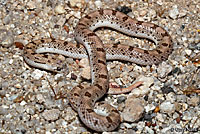 |
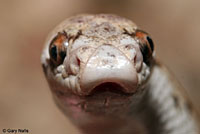 |
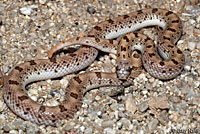 |
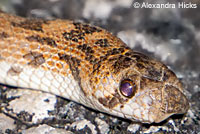 |
| |
Adult, Imperial County |
|
Adult, San Bernardino County
© Alexandra Hicks |
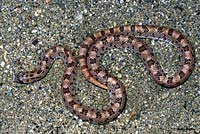 |
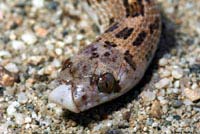 |
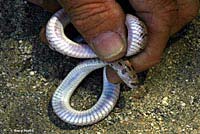 |
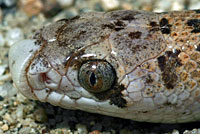 |
| Adult, Riverside County |
 |
 |
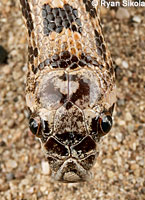 |
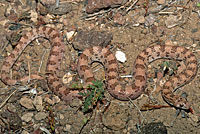 |
This aberrantly-patterned Spotted Leaf-nosed Snake was found in Imperial County. The dark saddles normally present on the dorsal surface are extended lengthwise almost into stripes.
© Stuart Young
|
Note how dark the nose is on this snake from dark lava habitat in San Bernardino County. © Ryan Sikola |
Adult, Inyo County |
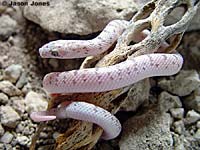 |
 |
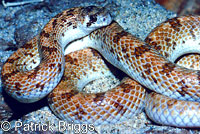 |
|
| Adult, San Diego County © Jason Jones |
Adult, Riverside County, © Patrick Briggs |
|
| |
|
|
|
| Juveniles |
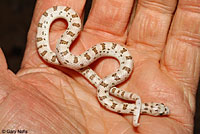 |
|
|
|
| Pale juvenile, Imperial County |
|
|
|
| |
|
|
|
| Habitat |
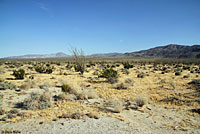 |
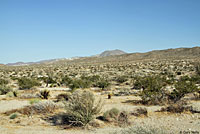 |
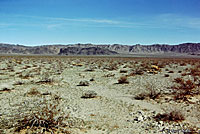 |
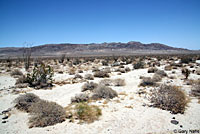 |
| Habitat, San Diego County desert |
Habitat, San Diego County desert |
Habitat, Riverside County desert
|
Habitat, San Diego County desert |
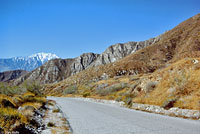 |
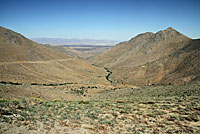 |
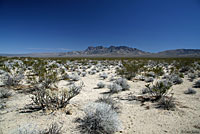 |
|
Habitat, riparian canyon,
Riverside County |
Habitat, Inyo County desert |
Habitat, San Bernardino County |
|
| |
|
|
|
| Short Videos |
 |
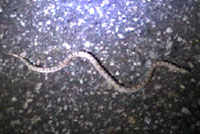 |
|
|
| A leaf-nosed snake craws across the desert floor. |
As shown here, this snake is typically found on a paved desert road at night. Using a serpentine motion, it is capable of moving quickly over the asphalt. |
|
|
|
|
|
|
|
Description |
Not Dangerous - This snake does not have venom that can cause death or serious illness or injury in most humans.
Commonly described as "harmless" or "not poisonous" to indicate that its bite is not dangerous, but "not venomous" is more accurate. (A poisonous snake can hurt you if you eat it. A venomous snake can hurt you if it bites you.)
|
| Size |
12 - 20 inches long (30 - 51 cm.)
|
| Appearance |
A small pale snake with dark blotches, smooth scales and a blunt snout.
The rostral scale over the nose is enlarged and raised above the level of the other scales, giving this snake its name, as the scale looks like part of a leaf folded over the nose. |
| Color and Pattern |
The ground color is pale tan, pink, or grayish with brown blotches on the back from the back of the head to the tail.
The underside is white and unmarked.
Pupils are vertical.
Some males may have weekly keeled scales.
|
| Life History and Behavior |
Activity |
Active at night.
The enlarged rostral scale may help this snake burrow through sand in search of prey.
When threatened, may draw back and strike.
Secretive - at one time thought to be very rare, until Laurence Klauber discovered that they were common after finding them on paved desert roads at night in 1922. |
| Diet and Feeding |
| Small lizards, especially banded geckos, and lizard eggs. |
| Reproduction |
Females are oviparous, laying eggs, probably from June - July.
|
| Habitat |
Sandy or gravelly deserts - open flats, washes, alluvial fans, foothills. Creosote bush is typically present. From below sea level in the Imperial Valley to about 4,000 ft. (1,200 m.)
|
| Geographical Range |
Occurs from Inyo County south through the Mojave and Colorado deserts up to the desert base of the mountain ranges. Ranges east into Nevada and the southwest edge of Utah, south to the Baja California cape region, and through western Arizona south along the western coast of Mexico.
|
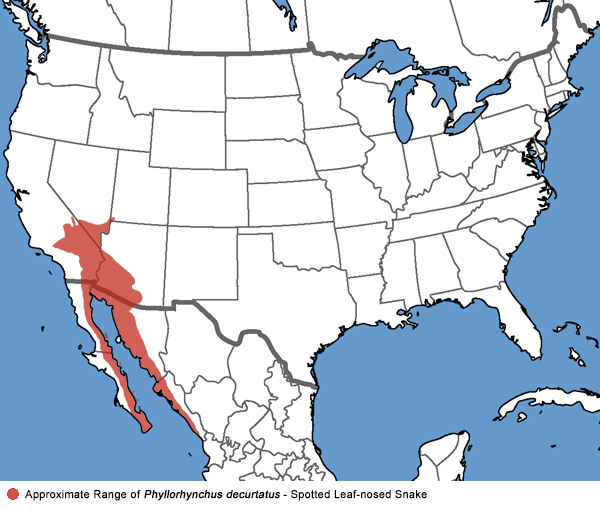 |
| Notes on Taxonomy |
| McDiarmid and McCleary (1993, Cat. Am. Amphib. Rept.:579.1-5) and Gardner and Mendelsoh (2004, J. Herpetology 28: 187-196) determined that no subspecies of Phyllorhynchus decurtatus should be recognized.
Previously, several subspecies of Phyllorhynchus decurtatus were recognized, including
P. d. perkinsi - Western Leaf-nosed Snake
P. d. nubilis - Clouded Leaf-nosed Snake
P. d. decurtatus - Baja California Leaf-nosed Snake
Alternate and Previous Names (Synonyms)
Phyllorhynchus decurtatus - Spotted Leaf-nosed Snake (Stebbins 2003, 2012)
Phyllorhynchus decurtatus perkensi - Western Leaf-nosed Snake (Stebbins 1954, 1966, 1985)
Phyllorhynchus decurtatus perkensi - Western Leaf-nosed Snake.(Klauber 1935)
Desert leaf-nosed snake; Leaf-nosed snake
|
| Conservation Issues (Conservation Status) |
| None |
|
| Taxonomy |
| Family |
Colubridae |
Colubrids |
Oppel, 1811 |
| Genus |
Phyllorhynchus |
Leaf-nosed Snakes |
Stejneger, 1890 |
Species
|
decurtatus |
Spotted Leaf-nosed Snake |
(Cope, 1868) |
|
Original Description |
Phyllorhynchus decurtatus - (Cope, 1868) - Proc. Acad. Nat. Sci. Philadelphia, Vol. 20, p. 310
from Original Description Citations for the Reptiles and Amphibians of North America © Ellin Beltz
|
|
Meaning of the Scientific Name |
Phyllorhynchus - Greek - phyllon = leaf + rhunkos = beak or snout - refers to the nose shield which "resembles a thick leaf"
decurtatus - Latin = having been cut short - refers to the short snout
from Scientific and Common Names of the Reptiles and Amphibians of North America - Explained © Ellin Beltz
|
|
Related or Similar Neighboring California Snakes |
H. t. deserticola - Desert Nightsnake
A. e. eburnata - Desert Glossy Snake
|
|
More Information and References |
California Department of Fish and Wildlife
Hansen, Robert W. and Shedd, Jackson D. California Amphibians and Reptiles. (Princeton Field Guides.) Princeton University Press, 2025.
Stebbins, Robert C., and McGinnis, Samuel M. Field Guide to Amphibians and Reptiles of California: Revised Edition (California Natural History Guides) University of California Press, 2012.
Stebbins, Robert C. California Amphibians and Reptiles. The University of California Press, 1972.
Flaxington, William C. Amphibians and Reptiles of California: Field Observations, Distribution, and Natural History. Fieldnotes Press, Anaheim, California, 2021.
Nicholson, K. E. (ed.). 2025. Scientific and Standard English Names of Amphibians and Reptiles of North America North of Mexico, with Comments Regarding Confidence in Our Understanding. Ninth Edition. Society for the Study of Amphibians and Reptiles. [SSAR] 87pp.
Samuel M. McGinnis and Robert C. Stebbins. Peterson Field Guide to Western Reptiles & Amphibians. 4th Edition. Houghton Mifflin Harcourt Publishing Company, 2018.
Stebbins, Robert C. A Field Guide to Western Reptiles and Amphibians. 3rd Edition. Houghton Mifflin Company, 2003.
Behler, John L., and F. Wayne King. The Audubon Society Field Guide to North American Reptiles and Amphibians. Alfred A. Knopf, 1992.
Robert Powell, Roger Conant, and Joseph T. Collins. Peterson Field Guide to Reptiles and Amphibians of Eastern and Central North America. Fourth Edition. Houghton Mifflin Harcourt, 2016.
Powell, Robert., Joseph T. Collins, and Errol D. Hooper Jr. A Key to Amphibians and Reptiles of the Continental United States and Canada. The University Press of Kansas, 1998.
Bartlett, R. D. & Patricia P. Bartlett. Guide and Reference to the Snakes of Western North America (North of Mexico) and Hawaii. University Press of Florida, 2009.
Bartlett, R. D. & Alan Tennant. Snakes of North America - Western Region. Gulf Publishing Co., 2000.
Brown, Philip R. A Field Guide to Snakes of California. Gulf Publishing Co., 1997.
Ernst, Carl H., Evelyn M. Ernst, & Robert M. Corker. Snakes of the United States and Canada. Smithsonian Institution Press, 2003.
Taylor, Emily. California Snakes and How to Find Them. Heyday, Berkeley, California. 2024.
Wright, Albert Hazen & Anna Allen Wright. Handbook of Snakes of the United States and Canada. Cornell University Press, 1957.
|
|
|
The following conservation status listings for this animal are taken from the July 2025 State of California Special Animals List and the July 2025 Federally Listed Endangered and Threatened Animals of California list (unless indicated otherwise below.) Both lists are produced by multiple agencies every year, and sometimes more than once per year, so the conservation status listing information found below might not be from the most recent lists, but they don't change a great deal from year to year.. To make sure you are seeing the most recent listings, go to this California Department of Fish and Wildlife web page where you can search for and download both lists:
https://www.wildlife.ca.gov/Data/CNDDB/Plants-and-Animals.
A detailed explanation of the meaning of the status listing symbols can be found at the beginning of the two lists. For quick reference, I have included them on my Special Status Information page.
If no status is listed here, the animal is not included on either list. This most likely indicates that there are no serious conservation concerns for the animal. To find out more about an animal's status you can also go to the NatureServe and IUCN websites to check their rankings.
Check the current California Department of Fish and Wildlife sport fishing regulations to find out if this animal can be legally pursued and handled or collected with possession of a current fishing license. You can also look at the summary of the sport fishing regulations as they apply only to reptiles and amphibians that has been made for this website.
This snake is not included on the Special Animals List, which indicates that there are no significant conservation concerns for it in California.
|
| Organization |
Status Listing |
Notes |
| NatureServe Global Ranking |
|
|
| NatureServe State Ranking |
|
|
| U.S. Endangered Species Act (ESA) |
None |
|
| California Endangered Species Act (CESA) |
None |
|
| California Department of Fish and Wildlife |
None |
|
| Bureau of Land Management |
None |
|
| USDA Forest Service |
None |
|
| IUCN |
|
|
|
|









































